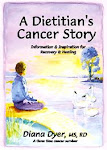First, I learned from an oncology dietitian colleague about an organization called The Ceres Community Project in Sonoma County California that provides healing foods, actually entire meals, made with locally-grown organic foods to individuals (and their family) with a life-threatening illness completely free of charge for three months. Although it will take a few minutes of your time, I think you will find watching the video on their website explaining their mission to be both heart-warming and inspiring. The model this non-profit organization has developed by having teens prepare the meals provides love and hope for the future throughout their community in many different ways. Does anyone know of other communities that have a non-profit organization like this?
Second, during the 10 minutes in the car Friday evening between our farm and home, I was lucky enough to hear the following interview on NPR with Gordon Murray, author of the book The Investment Answer.
One of the recipients for the Ceres Community Project states in the video that the healthy and lovingly-prepared meals certainly has very likely added "years to her life". Although not stating so in these exact words, my guess is that working so deliberately and lovingly to get this book to print before his death has also added time to Mr. Murray's life, with the bonus that intentionally working on this book to help others may have also added "life to his years".
I only recently read a quote attributed to Anne Frank, author of A Diary of a Young Girl,
“How wonderful it is that nobody need wait a single moment
before starting to improve the world.”
~~ Anne Frank (1929-1945)
Being aware of her uncertain outcome while in hiding during World War II because her family was Jewish had to be similar to living with a cancer diagnosis, being confronted with and coming to understand and accept the unfairness, suffering, and fragility of life plus also actively choosing to see life's beauty while looking forward with hope to the day that she could re-join the world. However, the truly inspiring aspect of Anne's life is that she did not wait to re-join the world to start 'improving it'. She only had today to live and to write. She would never know how her writing would spread the ripples from her spirit and her dreams throughout the world over the next several generations.
All of these people are shining examples of the quotation that I used to begin this blog back in June 2007:
"No one could make a greater mistake than he who did nothing
because he could only do a little"
~~ Edmund Burke (1729-1797)
My husband and I finally need to put down the hammers and paintbrushes to start baking, finish shopping, wrapping gifts, get our tree, oh dear, the list of things to do is very long! I'll come back to blogging in 2011. Until then, I send all my readers best wishes for a joyful holiday season, a hopeful new year, along with hope that you will find these stories as inspirational as I have.
"Cultivate your life - you are what you grow - inch by inch, row by row"
Diana Dyer, MS, RD































